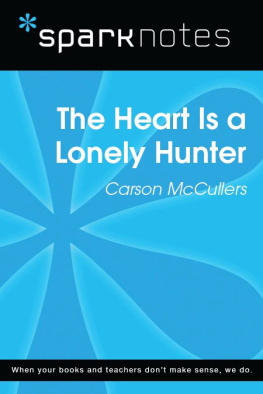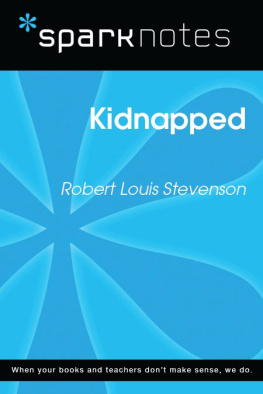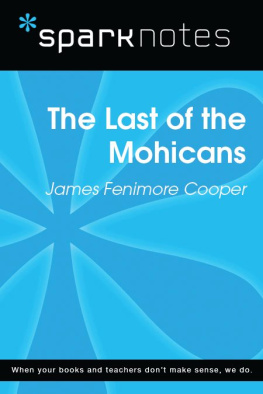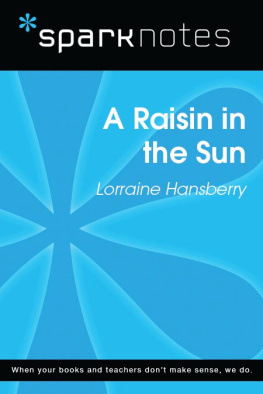The Heart Is a Lonely Hunter
Carson McCullers
2003, 2007 by Spark Publishing
This Spark Publishing edition 2014 by SparkNotes LLC, an Affiliate of Barnes & Noble
All rights reserved. No part of this publication may be reproduced, stored in a retrieval system, or transmitted in any form or by any means (including electronic, mechanical, photocopying, recording, or otherwise) without prior written permission from the publisher.
Sparknotes is a registered trademark of SparkNotes LLC
Spark Publishing
A Division of Barnes & Noble
120 Fifth Avenue
New York, NY 10011
www.sparknotes.com /
ISBN-13: 978-1-4114-7548-9
Please submit changes or report errors to www.sparknotes.com/.
10 9 8 7 6 5 4 3 2 1
Context
Carson McCullers was born Lula Carson Smith in Columbus, Georgia, on February 19, 1917. The Heart Is a Lonely Hunter (1940) was her first novelpublished when she was only twenty-three years oldand her most autobiographical.
McCullers's father was a jeweler and a watch repairman, and her mother worked for the jeweler who had employed her father before he opened his own store. The Smiths were of moderate means but were regarded as a highly respectable family. Carson became a passionate pianist in her teenage years, but soon realized that writing was her true calling. She once said that writing was her "search for God." Certain aspects of the character Mick in The Heart Is a Lonely Hunter are drawn from McCullers's own experience as she came of age.
Critics often compare McCullers to other Southern women writers of her timeEudora Welty, Flannery O'Connor, Katharine Anne Porterwhile others believe she is more closely linked to Thomas Wolfe, Sherwood Anderson, and William Saroyan. McCullers herself said that she wrote in the tradition of the Russian realists, an inclination she attributed to her Southern heritage. Identifying herself as a Southern writer, she was interested in the so-called "gothic" quality that many critics indiscriminately applied to Southern fiction. In an article entitled "The Russian Realists and Southern Literature," McCullers reacted against overuse of the term "gothic," saying she thought the Southern fiction of her generation was, on the contrary, rooted in realism and therefore did not depend on supernatural incidents or explanations. McCullers felt that the Russian realists of the nineteenth century and the Southern realists of the twentieth century had much in common, as both groups wrote about regions that had "peasant" classes.
McCullers worked on the manuscript that eventually became The Heart is a Lonely Hunter while she was studying writing at New York University and Columbia University. In her comments prefacing the outline she sent to a publisher, McCullers makes it clear that the novel is about "five isolated, lonely people in their search for expression and spiritual integration with something greater than themselves." She explains the novel's three-part structure as a fugue (a musical composition featuring several repeating themes): Part One introduces the broad theme of "man's revolt against his own inner isolation and his urge to express himself as fully as possible" as one voice, first through John Singer and then through the other major characters. Part Two demonstrates the inevitable failure of each person, which is brought on by a combination of free will and environmental entrapment. Part Three functions as a coda; the situations of the characters ultimately end up worse than they were before Singer entered their lives.
McCullers sets off the novel's principal thememan's struggle against isolation and his need for expressionby using five "counter-themes" (McCullers conceived her projected novel as a work of music). Each of these five counter-themesthe need for people to create a unifying deity or principle, the likelihood that any such manmade god will be an illusion, the societal suppression of individuality, the perversion of man's urge to cooperate with others, and the shining moments of heroism that occasionally characterize otherwise ordinary individualsdevelops and elaborates on the principal theme.
Plot Overview
The first chapter of The Heart Is a Lonely Hunter introduces us to John Singer and Spiros Antonapoulos, two good friends who live together in a town in the Deep South and who are both deaf-mutes. Antonapoulos works in his cousin's fruit store, and Singer works as a silver engraver in a jewelry shop. They spend ten years living together in this way.
One day Antonapoulos gets sick, and even after he recovers he is a changed man. He begins stealing and urinating on buildings, and exhibiting other erratic behavior. Finally, Antonapoulos's cousin sends him to a mental asylum, although Singer would rather have Antonapoulos stay with him. After Antonapoulos leaves, Singer moves into a local boarding house in town run by a family named the Kellys.
The narrator then introduces us to Biff Brannon, the proprietor of the New York Caf, the establishment in town where Singer now eats all his meals. Biff is lounging on the counter watching a new patron named Jake Blount, as the constantly drunk Jake is intriguing. Blount goes over and sits with Singer and begins talking to him as though the two are good friends. Then Singer leaves. Once Jake realizes in his drunken stupor that Singer has left, he goes into an alley and begins beating his head and fists against a brick wall until he is bruised and bloody. The police bring Jake back to the caf, and Singer volunteers to let the drunk stay the night with him.
The narrative shifts to the perspective of Mick Kelly, the young teenage daughter of the couple who own the boarding house where Singer is staying. Mick spends her summer days looking after her two younger brothers, Bubber and Ralph. Mick is passionate about music, and she tries to make a violin out of a ukulele and strings from various different instruments. She is frustrated when her attempt fails.
The narrative switches to Blount's point of view. Jake applies for and lands a job as a mechanic at a local carnival. He tries to tell some workers about his socialist ideas on his way home, but they laugh at him. He soothes himself by going back to John Singer's place, talking to him and drinking.
Then the narrative switches to Dr. Copeland's perspective. Dr. Copeland is a black physician in town. He is angered by a story his daughter, Portia, tells him about a scam artist who took lots of black people's money. He wishes that his children had grown up to be well-educated, successful leaders for the black race rather than accepting the traditional, demeaning, menial jobs that are usually available to blacks in the South at this time. Dr. Copeland remembers a night when John Singer lit a cigarette for himthe first time the Doctor has experienced an act of courtesy from a white man in his entire life.
By the end of Part One, Mick, Biff, Jake, and Dr. Copeland have all begun to visit Singer regularly, all taking comfort in him as a confidant.
At the opening of Part Two, Mick throws a party with kids from school. During the party, she and her neighbor Harry Minowitz take a stroll around the block. Harry, a Jewish boy, tells Mick how much he hates the Nazis. Later that night, Mick, hiding in the bushes outside a house in the rich neighborhood, overhears on the radio a Beethoven symphony for the first time. She is very moved by it.
Biff's wife, Alice, dies after surgery to remove a tumor. Biff is not overly sad about it because he and Alice had fallen out of love. He and his sister-in- law, Lucile Wilson, and Lucile's daughter. Baby, come over to talk to Biff before they go to the funeral. Biff tells Lucile that once he beat up her ex-husband, Leroy, because Leroy had been bragging about how he beat her. The three of them then set off for the funeral.



















